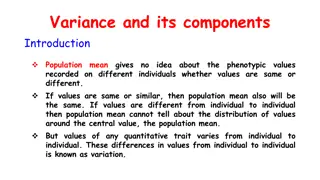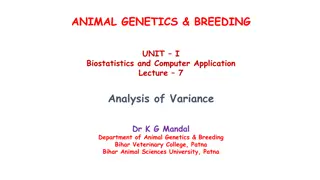Approaches to Variance Estimation in Social Policy Research
This lecture discusses approaches to estimating sampling variance and confidence intervals in social policy research, covering topics such as total survey error, determinants of sampling variance, analytical approaches, replication-based approaches, and the ultimate cluster method. Various methods are explored, including linearization, asymptotic theory, and inductive approaches like balanced repeated replication and the bootstrap method. It emphasizes the importance of considering sample design in variance estimation.
Download Presentation

Please find below an Image/Link to download the presentation.
The content on the website is provided AS IS for your information and personal use only. It may not be sold, licensed, or shared on other websites without obtaining consent from the author.If you encounter any issues during the download, it is possible that the publisher has removed the file from their server.
You are allowed to download the files provided on this website for personal or commercial use, subject to the condition that they are used lawfully. All files are the property of their respective owners.
The content on the website is provided AS IS for your information and personal use only. It may not be sold, licensed, or shared on other websites without obtaining consent from the author.
E N D
Presentation Transcript
Lecture 2: Approaches to variance estimation Tim Goedem Herman Deleeck Centre for Social Policy 18 January 2018 EUROMOD Winter School, University of Antwerp
Overview 1. Total survey error and the sampling variance 2. The sampling variance 3. The determinants of the sampling variance 4. Approaches to variance estimation 5. The ultimate cluster method 6. Analysing subpopulations 7. Comparing point estimates 8. Conclusion 2
Problem We need estimate of sampling variability We do not observe: - Population distribution - Sampling distribution How to estimate sampling variance and confidence intervals? 3
4. Approaches 2 most common approaches: 1. Analytical approaches 2. Replication-based approaches 4
4. Approaches Analytical approaches - (non)linear statistics are expressed as totals; linearization (Taylor series expansion); - use a standard formula for estimating variance of linearized estimator, asymptotic theory - A sampling distribution is assumed to estimate confidence intervals and significance tests 5
4. Approaches Inductive approaches: Are based on replication of the original sample (or replicate weights) random groups method, Balanced repeated replication, Jackknife Repeated Replication, the bootstrap (and replicate weights) Advantages: can be used when no analytical formula (estimation command) is available; no assumptions about the shape of the sampling distribution But computationally intensive; bias 6
4. Approaches Whichever approach is chosen, they only work when taking account of the sample design 7
4. Approaches 95% Confidence interval of % in severe material deprivation, BE, EU-SILC 2010 8 7 6 5 4 3 2 1 0 8 persons postcode sectors full sample design
5. Ultimate cluster aproach How to take account of many different types of sample designs? Analytical formula very complex 9
EU-SILC sample design(s) Source: Berger et al. (2017) 10
EU-SILC sample design(s) Special features Rotational panel design - Sometimes longer panel or pure panel (FR, LU, NO) - Rotation at level of PSUs or within PSUs Quota sampling in DE until 2008 (Multiple) changes in sample design over time (esp. HU) Calibration on microcensus in NL; on income variables in e.g. SE, FI, Probabilities of selection >1 (e.g. BE) 11
1 = rotation at PSU level 2 = rotation within PSUs 12
5. Ultimate cluster method Only take account of the first stage of the sample design (stratification and clustering) Assume there is no subsampling within PSUs: work with observations of PSUs in the condition they are found in the sample Assume sampling with replacement 13
5. Ultimate cluster method Why: ease of computation Second and subsequent stages add little variance if sampled fraction of PSUs is small (which is often the case) 14
5. Ultimate cluster method Within-stratum variance for the mean (simple random, equal clusters) (Kish, 1965) 1-a/A and 1-b/B = FPC S (a)=between-cluster S (b)=within-cluster 15
5. Ultimate cluster method Need of good sample design variables to: Identify PSUs Identify Primary strata Take account of calibration (post-stratification, raking) 16
5. Ultimate cluster method Strata with one PSU: - One of many PSUs selected (with respondents) -> join similar strata (on sampling frame) - Self-representing PSU? -> PSU is stratum, use next stage of sample design as PSUs 17
5. Ultimate cluster method Remarks: Sample design variables should refer to moment of selection (not interview) PSU codes must at least be unique within strata Panels: use consistent PSU and strata codes Degrees of freedom: #PSUs-#Strata 18
5. Ultimate cluster method In Stata use sample design variables to identify the sample design svyset PSU [pweight = weight], strata(strata) Subsequently: svy: commands SPSS: CSPLAN R: survey package (svydesign and other commands) SAS: PROC SURVEYFREQ and others 19
The EU-SILC sample design variables In EU-SILC, the following sample design variables are available: DB050: primary strata (not included in the EU-SILC UDB) DB060: primary sampling units DB062: secondary sampling units DB070: order of selection of primary sampling units 20
The EU-SILC sample design variables Especially for earlier waves, quite a few problems. 1/ Missing information DB050 lacking DB060 lacking (esp. earlier waves, or for older rotational panels) With missing DB050: no unique DB060 across strata (e.g. PL, SI); no unique DB070 (UK) No secondary strata in case of self-representing PSUs When households are split (AT, earlier waves) Calibration, imputation 21
The EU-SILC sample design variables Especially for earlier waves, quite a few problems. 2/ Moment of selection vs. moment of interview DB050 x DB040 (ES, FR, until EU-SILC 2008 at least) DB040 as proxy for DB050 Moving households wrongly received new PSU code (UK) 22
The EU-SILC sample design variables Especially for earlier waves, quite a few problems. 3/ Multiple hits => unique DB060 code Sampling of PSUs with replacement Was not always the case, esp. BE & LV 23
The EU-SILC sample design variables Especially for earlier waves, quite a few problems. 4/ Strata with 1 PSU Reason was not always clear - Self-representing PSUs (e.g. IT, UK, FR) - One PSU observed out of many? Turn into stratum vs. collapsing strata 24
The EU-SILC sample design variables Especially for earlier waves, quite a few problems. 5/ Inconsistent PSU codes Across rotational panels Across waves 25
The EU-SILC sample design variables 1. Standard error of difference is much smaller with consistent SD variables. 2. Difference with 2011: the longer the time-span, the weaker the covariance (and the larger the standard error) will be 26
The EU-SILC sample design variables Especially for earlier waves, quite a few problems. 6/ changes in sample design AT: introduced multi-stage with stratification NO: abandoned multi-stage design HU: change for many rotational panels In principle sample elements could have been drawn under different sample designs at the same time 27
The EU-SILC sample design variables Making the best of what we have Do-files at https://timgoedeme.com/eu-silc-standard-errors/ Run do-file on D-file of EU-SILC Then merge with other EU-SILC files svyset psu1 [pw=rb050], strata(strata1) 28
The EU-SILC sample design variables Making the best of what we have DB040 as proxy for DB050 - Regroup if possible DB060, or hid (DB030) Try to identify / treat special cases - Self-representing PSUs (e.g. IT) - Make codes consistent / unique across rotation panels - Conservative when not both strata and PSUs are available 29
The EU-SILC sample design variables Making the best of what we have Each stratum and each PSU unique identifier across entire dataset But not consistent across waves Should be made unique across waves (i.e. add year- code) for comparisons between waves. 30
Steps in analysis 1. definition of the problem 2. Check sample designs and sample design variables (including weights, correlation between weights and variables of interest, ...) 3. Svyset the data and check the sample design, in function of the analysis of interest 4. Inspect missings and imputation -> multiple imputation possible? 5. Inspect outliers and apply proper treatment 6. run proper analysis and interpret results 7. report results, including precision of estimates 31
Conclusion Key messages 1. If estimates are based on samples -> estimate and report SEs, CIs & p-values 2. Always take as much as possible account of sample design when estimating SEs, CIs & p-values 3. Never delete observations from the dataset 4. Never simply compare confidence intervals 32
Literature Goedem , T. (2013) How much confidence can we have in EU-SILC? , Social indicators research, 110(1): 89-110, doi:10.1007/s11205-011-9918-2 Heeringa, S. G., West, B. T. and Berglund, P. A. (2010), Applied Survey Data Analysis, Boca Raton: Chapman & Hall/CRC, 467p. Wolter, K. M. (2007), Introduction to Variance Estimation, New York: Springer, 447p. https://timgoedeme.com/eu-silc-standard-errors/. 33
Thanks! tim.goedeme@ua.ac.be 34























